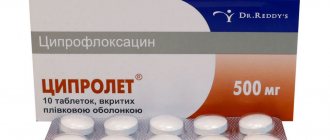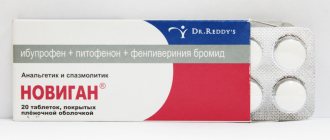Instructions for use KETONAL® (KETONAL)
The simultaneous use of Ketonal with NSAIDs, including selective COX-2 inhibitors, should be avoided.
Undesirable effects can be minimized by prescribing the drug at the minimum dose for the shortest period of time necessary to control symptoms.
Elderly patients have an increased incidence of side effects of NSAIDs, especially gastrointestinal bleeding and perforation, which can be fatal.
Gastrointestinal bleeding, ulceration or perforation with risk of death has been reported for all NSAIDs at any stage of treatment, with or without warning symptoms or a history of previous severe gastrointestinal illness.
Some epidemiological data suggest that ketoprofen may be associated with a higher risk of severe gastrointestinal toxicity compared with some other NSAIDs, especially at high doses.
In patients with a history of peptic ulcer disease, especially those complicated by bleeding or perforation, and in elderly patients, the risk of gastrointestinal bleeding, ulceration or perforation increases with increasing doses of NSAIDs. In such patients, treatment should be started with the minimum effective dose.
For these patients, as well as for patients who require concomitant use of low-dose acetylsalicylic acid or other drugs that increase the risk of gastrointestinal complications, concomitant administration of drugs that protect the gastrointestinal mucosa (for example, misoprostol or proton pump blockers) may be required.
Patients who have experienced gastrointestinal toxicity, especially elderly patients during the initial stages of treatment, should report any unusual abdominal symptoms. The risk of gastrointestinal bleeding should be kept in mind.
Caution is required when using the drug in patients receiving concomitant therapy with drugs that may increase the risk of ulcerative lesions or bleeding, for example, ingestion of corticosteroids, anticoagulants such as warfarin, selective serotonin reuptake inhibitors or antiplatelet agents such as acetylsalicylic acid.
If gastrointestinal bleeding or ulceration develops in patients receiving ketoprofen, treatment should be discontinued.
NSAIDs should be prescribed with caution to patients with a history of gastrointestinal diseases (ulcerative colitis, Crohn's disease), because their aggravation is possible.
Cardiovascular and cerebrovascular effects:
- Appropriate monitoring and consultation are required for patients with a history of hypertension and/or mild to moderate congestive heart failure, manifested by fluid retention or edema, associated with NSAID treatment.
Clinical experience and epidemiological data suggest that the use of some NSAIDs (especially at high doses and during long-term treatment) may be associated with an increased risk of arterial thrombosis (eg, myocardial infarction or stroke). There is insufficient data to exclude such a risk for ketoprofen.
In patients with uncontrolled hypertension, congestive heart failure, known coronary artery disease, peripheral arterial disease and/or cerebrovascular disease, treatment with ketoprofen should be undertaken only after careful assessment of the appropriateness of its use. Such an analysis should be done before starting long-term treatment in patients with risk factors for cardiovascular disease (for example, hypertension, hyperlipidemia, diabetes mellitus, smoking).
Patients suffering from bronchial asthma, in combination with chronic rhinitis, chronic sinusitis and/or nasal polyposis, are more likely to experience allergic reactions after taking acetylsalicylic acid and/or NSAIDs than in the general population. Administration of this product may cause an attack of bronchial asthma.
Caution is also required in patients with hemostasis disorders, hemophilia, von Willebrand disease, severe thrombocytopenia and renal or liver failure, as well as in those taking anticoagulants (coumarin and heparin derivatives, low molecular weight heparins).
In patients with liver damage receiving diuretics, after major surgical interventions with developed hypovolemia, and especially in elderly patients, urine output and renal function should be carefully monitored.
Ketoprofen should be prescribed with caution to patients with chronic alcoholism.
Severe skin reactions (some of them fatal) such as exfoliative dermatitis, Stevens-Johnson syndrome and toxic epidermal necrolysis have been observed extremely rarely in association with the use of NSAIDs. Patients are at greatest risk of developing these reactions at the beginning of treatment; in most cases, the occurrence of a reaction is noted within the first month of treatment. Ketonal® should be discontinued at the first appearance of a skin rash, changes in the mucous membranes or other signs of hypersensitivity.
As with any long-term treatment with non-steroidal antirheumatic drugs, therapy with ketoprofen requires monitoring of blood cells, as well as liver and kidney function, especially in elderly patients. When CC < 20 ml/min, dose adjustment of ketoprofen is necessary.
Like other NSAIDs, ketoprofen mask the signs and symptoms of infectious diseases.
Ketonal® should be discontinued before major surgery.
Ketonal® capsules 50 mg and Ketonal® forte contain lactose. Therefore, the drug should not be prescribed to patients with rare hereditary galactose intolerance, lactase deficiency or impaired absorption of glucose or galactose.
Ketonal® injection solution contains 12.3 vol% ethanol. Every 2 ml dose contains 0.2 g of ethanol. This may have a negative effect on patients with alcoholism, those with brain damage or disease, or pregnant or breastfeeding women.
Impact on the ability to drive vehicles and operate machinery
Patients should be warned about the possible occurrence of drowsiness, dizziness, or convulsions while taking the drug. If there is a risk of developing such reactions, patients should refrain from driving vehicles and operating machinery.
Results of preclinical safety studies
Acute toxicity. After oral administration, the LD50 of ketoprofen was 360 mg/kg in mice, 160 mg/kg in rats, and 1300 mg/kg in guinea pigs. The LD50 of ketoprofen is several times higher than that of indomethacin.
Chronic toxicity. Ketoprofen was administered orally to rats for 4 weeks at doses of 2, 6 or 18 mg/kg. 10% of animals receiving ketoprofen at a dose of 18 mg/kg died on days 6-30, some had ulceration of the intestinal mucosa. In dogs receiving the same dose, only intestinal ulcerations were described, while no animals died. Among the animals receiving indomethacin at a dose of 6 mg/kg body weight, half died; all animals receiving 18 mg/kg body weight died.
In a 6-month study, rats were administered orally ketoprofen at doses of 3, 6 or 9 mg/kg. After 8 weeks, 53% of male rats treated with 6 mg/kg and 67% of male and 20% of female rats treated with 9 mg/kg died. In animals receiving 9 mg/kg, plasma concentrations of all proteins decreased and spleen weight increased. and liver. Histopathological studies of tissues from surviving animals did not reveal significant pathological changes.
Carcinogenicity, mutagenicity and effects on fertility. Long-term toxicity studies in mice administered orally ketoprofen up to 32 mg/kg/day did not reveal carcinogenic effects of this drug. The Ames test did not show any mutagenic properties. Ketoprofen did not affect the fertility of male rats that received up to 9 mg/kg/day orally. In female rats receiving 6 or 9 mg/kg/day, the number of implantations was reduced. In male rats and dogs, suppression of spermatogenesis was found. Dogs and male monkeys treated with high doses of ketoprofen experienced a decrease in testicular weight.
Teratogenicity. Neither teratogenic effects nor effects on the fetus were shown in mice receiving ketoprofen up to 12 mg/kg/day and in rats receiving up to 9 mg/kg/day. In rabbits, doses of ketoprofen toxic to the maternal organism were embryotoxic, but had a teratogenic effect.
Ketonal film-coated tablets 100 mg 20 pcs. in Istra
Ketoprofen should not be combined with other NSAIDs and/or COX2 inhibitors.
With long-term use of NSAIDs, it is necessary to periodically evaluate a clinical blood test, monitor kidney and liver function, especially in elderly patients (over 65 years), and conduct a stool test for occult blood.
It is necessary to be careful and monitor blood pressure more often when using ketoprofen to treat patients suffering from arterial hypertension and cardiovascular diseases that lead to fluid retention in the body.
If visual disturbances occur, treatment should be stopped immediately.
Like other NSAIDs, ketoprofen can mask the symptoms of infectious and inflammatory diseases. If you notice signs of infection or deterioration in health while using the drug, you should immediately consult a doctor.
If there is a history of contraindications from the gastrointestinal tract (bleeding, perforation, peptic ulcer), long-term therapy and the use of high doses of ketoprofen, the patient should be under close medical supervision.
Because of the important role of prostaglandins in maintaining renal blood flow, particular caution should be exercised when using ketoprofen in patients with cardiac or renal insufficiency, as well as in the treatment of elderly patients taking diuretics and patients who, for any reason, have a decrease in circulating volume. blood.
The drug should be discontinued before major surgery.
The use of ketoprofen can affect female fertility, therefore, patients with infertility (including those undergoing examination) are not recommended to use the drug.
Impact on the ability to drive vehicles and machinery
There is no data on the negative effect of the drug Ketonal® in recommended doses on the ability to drive a car or operate machinery. At the same time, patients who experience drowsiness, dizziness or other unpleasant sensations from the nervous system, including visual impairment, while using the drug, should refrain from driving vehicles and engaging in potentially hazardous activities that require increased concentration and speed of psychomotor reactions.
Ketonal forte tablets p/o 100 mg No. 20 No. 1
Name
Ketonal forte tablet coated. captivity. about 100 mg per bottle. No. 20 in pack No. 1
Description
Light blue, round, biconvex film-coated tablets.
Main active ingredient
Ketoprofen
Release form
Pills
Dosage
Keep out of the reach of children. Store at a temperature not exceeding 25°C. Store in original packaging.
pharmachologic effect
Pharmacodynamics
Ketoprofen, the active ingredient of the drug, inhibits the synthesis of prostaglandins and leukotrienes by blocking the enzyme cyclooxygenase (cyclooxygenase-1 (COX-1) and cyclooxygenase-2 (COX-2)), which catalyzes the synthesis of prostaglandins in the metabolism of arachidonic acid. Ketoprofen stabilizes lysosomal membranes in vitro and in vivo, in high concentrations inhibits the synthesis of leukotrienes in vitro and has anti-bradykinin activity in vivo. The mechanism of the antipyretic effect of ketoprofen is unknown. It is possible that ketoprofen inhibits the synthesis of prostaglandins in the central nervous system (most likely in the hypothalamus). In some women, ketoprofen reduces the symptoms of primary dysmenorrhea, probably by suppressing the synthesis and/or effectiveness of prostaglandins.
Pharmacokinetics
Ketoprofen is well absorbed from the gastrointestinal tract. After taking 100 mg of ketoprofen orally, its peak plasma concentration (10.4 mcg/ml) is reached in 1 hour 22 minutes. The bioavailability of ketoprofen after oral administration at a dose of 50 mg is 90% and increases linearly with increasing doses. Ketoprofen is a racemic mixture, but the pharmacokinetics of the two enantiomers are similar. 99% of ketoprofen binds to plasma proteins, mainly to the albumin fraction. The volume of distribution in tissues is 0.1-0.2 l/kg. Ketoprofen penetrates into the synovial fluid. Three hours after the administration of 100 mg of ketoprofen, its concentration in plasma is about 3 μg/ml, and the concentration in synovial fluid is 1.5 μg/ml. After nine hours, its concentration in plasma is about 0.3 μg/ml, and the concentration in synovial fluid is 0.8 μg/ml. This means that ketoprofen slowly penetrates into the synovial fluid and is also slowly eliminated from it, while its plasma concentration decreases further. If ketoprofen is taken with food, absorption slows down and plasma concentrations decrease slightly, but bioavailability remains the same. After oral administration of 50 mg ketoprofen with meals four times a day, a peak concentration of 3.9 μg/ml was achieved in 1.5 hours compared to 2.0 μg/ml after two hours when taking ketoprofen on an empty stomach. Equilibrium concentrations of ketoprofen are established 24 hours after its administration. In elderly patients, steady-state concentration was reached after 8.7 hours and was 6.3 mcg/ml. Ketoprofen is extensively metabolized by liver microsomal enzymes. It binds to glucuronic acid and is excreted in this form from the body. After oral administration, its plasma clearance is 1.16 ml/min/kg. Due to its rapid metabolism, its biological half-life is only two hours. Up to 80% of ketoprofen is excreted in the urine, mainly (over 90%) in the form of ketoprofen glucuronide, and about 10% is excreted in the feces. Special groups of patients With liver damage In patients with liver failure, probably due to hypoalbuminemia (free biologically active ketoprofen), the concentration of ketoprofen almost doubles, which requires the administration of a minimum daily dose that provides a sufficient therapeutic effect. With kidney damage In patients with renal failure, the clearance of ketoprofen is reduced. Therefore, in case of severe renal failure, a dose reduction is required.
Indications for use
Ketonal forte is a non-steroidal antirheumatic drug with anti-inflammatory, analgesic and antipyretic effects. It is used for pain relief in a range of pain syndromes and for the treatment of inflammatory, degenerative and metabolic rheumatic diseases. Indications for use: - rheumatoid arthritis; - ankylosing spondylitis; - acute gout; — osteoarthritis of various localizations; - lumbosacral radiculitis, radiculitis; - myalgia; - tendinitis, tendovaginitis, bursitis, synovitis, capsulitis; - bruises, ligament damage, dislocations; - sprains, muscle tears - phlebitis, superficial thrombophlebitis, lymphangitis; - painful inflammatory diseases in dentistry, otolaryngology, urology and pulmonology.
Directions for use and doses
For oral administration. Undesirable effects can be minimized by taking the drug at the lowest effective dose for the shortest possible time necessary to relieve symptoms. The usual dose is 1-2 tablets per day, between meals. The maximum daily dose of ketoprofen is 200 mg. Before starting treatment at a dose of 200 mg per day, the possible risks and benefits should be carefully weighed. The use of higher doses is not recommended (see also “Special instructions and precautions”). Elderly patients and patients with impaired renal function It is recommended to reduce the initial dose and prescribe maintenance therapy using the lowest effective dose. If the drug is well tolerated, dose adjustment can be considered on an individual basis. Patients with impaired liver function Such patients should be closely monitored and the drug should be used at the lowest effective daily dose. Children The safety and effectiveness of ketoprofen in children have not been studied.
Use during pregnancy and lactation
Inhibition of prostaglandin synthesis may have a negative effect on pregnancy and/or embryo/fetal development. In the first and second trimesters of pregnancy, the drug should not be prescribed unless absolutely necessary. If Ketonal Forte is used by a woman who is trying to become pregnant or who is in the first or second trimester of pregnancy, the dose should be as low as possible and the duration of treatment should be as short as possible. In the third trimester of pregnancy, the use of Ketonal forte is contraindicated. There are no data on the penetration of the drug into milk. It is not recommended to prescribe Ketonal forte to nursing mothers.
Precautionary measures
Avoid simultaneous use of the drug with NSAIDs, including selective COX-2 inhibitors. Older adults are more likely to experience adverse reactions to NSAIDs, especially gastrointestinal bleeding and perforation, which can be fatal (see Dosage and Administration). Gastrointestinal bleeding, ulceration, and perforation Gastrointestinal bleeding, ulceration, or perforation, which may be fatal, has been reported for all NSAIDs and may occur at any time during treatment, with or without preexisting symptoms or severe gastrointestinal disease. tract in the anamnesis. Taking Ketonal forte may be associated with a high risk of severe gastrointestinal toxicity, which is typical for some other NSAIDs, especially when taken in high doses (see also “Doses and route of administration” and “Contraindications”). The risk of gastrointestinal bleeding, ulceration or perforation increases with increasing doses of NSAIDs, in patients with a history of peptic ulcer disease, especially complicated by bleeding or perforation (see "Contraindications"), as well as in the elderly. Treatment of these patients should be started with the lowest dose available. For these patients, as well as for patients concomitantly taking low-dose acetylsalicylic acid or other drugs that increase the risk of gastrointestinal complications, combination therapy with protective drugs (eg, misoprostol or proton pump blockers) should be considered (see below and “Interaction with other medicinal products and other types of interactions”). Patients with a history of gastrointestinal toxicity, especially the elderly, should report any unusual abdominal symptoms (especially gastrointestinal bleeding), especially early in treatment. Particular caution should be exercised when co-administered with drugs that may increase the risk of ulceration or bleeding, such as oral corticosteroids, anticoagulants (eg, warfarin), selective serotonin reuptake inhibitors, or antiplatelet agents such as acetylsalicylic acid (see Interactions with other medications and other types of interactions"). If patients experience gastrointestinal bleeding or ulcers during treatment with Ketonal forte, the drug should be discontinued. NSAIDs should be prescribed with caution to patients with a history of gastrointestinal diseases (ulcerative colitis, Crohn's disease), since they may experience exacerbations of these diseases (see “Side Effects”). Cardiovascular and cerebrovascular effects. Patients with a history of hypertension and/or mild to moderate congestive heart failure require appropriate monitoring and counseling as fluid retention and edema have been reported with the use of NSAIDs. The use of some NSAIDs (especially at high doses and during long-term treatment) may be associated with an increased risk of arterial thrombosis (eg, myocardial infarction or stroke) (see Warnings and Precautions). There is insufficient data to exclude such a risk for ketoprofen. In patients with uncontrolled arterial hypertension, congestive heart failure, established diagnosis of coronary artery disease, peripheral arterial disease and/or cerebrovascular disease, treatment with Ketonal Forte should be carried out only after a careful assessment of benefits and risks. The same should be done before prescribing long-term treatment for patients with risk factors for cardiovascular disease (eg, hypertension, hyperlipidemia, diabetes mellitus, smoking). Patients suffering from bronchial asthma in combination with chronic rhinitis, chronic sinusitis and/or nasal polyposis are more likely to experience allergic reactions after taking acetylsalicylic acid and/or NSAIDs than other patients. Prescribing Ketonal forte may cause an attack of bronchial asthma or bronchospasm, especially in patients with an allergy to acetylsalicylic acid or NSAIDs (see “Contraindications”). In patients with heart failure, cirrhosis and nephrotic syndrome, as well as in patients taking diuretics and in patients with chronic renal failure, especially the elderly, renal function should be carefully monitored at the start of treatment. In such patients, the administration of Ketonal forte may cause a decrease in renal blood flow due to inhibition of prostaglandin synthesis and lead to decompensation of renal function. In patients with abnormal liver function tests or a history of liver disease, blood transaminase levels should be periodically monitored, especially during prolonged therapy. Rare cases of jaundice and hepatitis have been described in connection with the use of ketoprofen. Treatment should be discontinued if visual disturbances such as blurred vision occur. The drug is prescribed with caution to persons suffering from alcohol dependence. Severe skin reactions (some of them fatal) associated with the use of NSAIDs, such as exfoliative dermatitis, Stevens-Johnson syndrome and toxic epidermal necrolysis, have been reported extremely rarely (see “Side effects”). The greatest risk of developing these reactions is at the beginning of the course of treatment; in most cases, reactions occur in the first month of treatment. Ketonal forte should be discontinued at the first appearance of a skin rash, lesions on the mucous membranes or other signs of hypersensitivity. Ketonal forte can mask the signs and symptoms of infectious diseases, such as elevated body temperature. Before extensive surgical interventions, the drug must be discontinued. The use of Ketonal forte may reduce fertility, so it is not recommended for women planning pregnancy. In women experiencing difficulties in achieving pregnancy or being examined for infertility, discontinuation of Ketonal forte should be considered. Ketonal forte tablets contain lactose. Therefore, they should not be taken by patients with hereditary galactose intolerance, lactase deficiency or impaired absorption of glucose and galactose.
Interaction with other drugs
Drug combinations not recommended Other NSAIDs (including selective cyclooxygenase-2 inhibitors) and salicylates in high doses: increased risk of ulcers and bleeding in the gastrointestinal tract. Anticoagulants (heparin and warfarin) and platelet aggregation inhibitors (eg, ticlopidine, clopidogrel): increased risk of bleeding (see Warnings and Precautions). If co-administration is necessary, close medical supervision is required. Lithium: Risk of increased plasma lithium levels, which can sometimes reach toxic levels due to decreased renal excretion of lithium. If necessary, plasma lithium concentrations should be carefully monitored and the dose of lithium adjusted during and after NSAID treatment. Methotrexate in doses exceeding 15 mg/week: increased risk of hematotoxicity of methotrexate, especially if used in high doses (>15 mg/week), which is likely due to the displacement of methotrexate from protein binding and reduced renal clearance. Combinations Requiring Caution Diuretics: Patients receiving diuretics, especially those with dehydration, are at increased risk of renal failure due to decreased renal blood flow due to inhibition of prostaglandin synthesis. Such patients should be adequately hydrated before initiating concomitant use of these drugs, and renal function should be monitored at the start of treatment (see "Special Instructions and Precautions"). Angiotensin-converting enzyme (ACE) inhibitors and angiotensin II receptor antagonists. In patients with impaired renal function (eg, dehydrated patients or the elderly), concomitant use of an ACE inhibitor or angiotensin II receptor antagonist and cyclooxygenase inhibitors may cause further deterioration of renal function, including possible acute renal failure. Methotrexate in doses below 15 mg/week: in the first weeks of combination treatment, it is necessary to monitor the detailed blood picture once a week. If there is any impairment of renal function and in elderly patients, monitoring should be carried out more often. Corticosteroids: Increased risk of developing ulcers or bleeding in the gastrointestinal tract (see Warnings and Precautions). Pentoxifylline: increases the risk of bleeding. More frequent clinical monitoring and more frequent control of bleeding time are necessary. Combinations that need to be considered Antihypertensive drugs (beta blockers, ACE inhibitors, diuretics): ketoprofen reduces the effect of antihypertensive drugs (inhibition of the synthesis of vasodilator prostaglandins). Thrombolytics: increased risk of bleeding. Selective serotonin reuptake inhibitors: increased risk of gastrointestinal bleeding (see "Special Instructions and Precautions"). Probenecid: Concomitant use of probenecid may significantly reduce the plasma clearance of ketoprofen. Combinations that should also be taken into account: Cyclosporine, tacrolimus: risk of additive nephrotoxicity, especially in elderly patients.
Contraindications
- Hypersensitivity to ketoprofen or any of the excipients of the drug; - a history of rhinitis, bronchospasm, bronchial asthma, urticaria or allergic reactions after using ketoprofen or similar active substances, such as other nonsteroidal anti-inflammatory drugs (NSAIDs) or salicylates (eg, acetylsalicylic acid); in such patients, severe (in rare cases fatal) anaphylactic reactions have been described (see “Side effects”); - severe heart failure; — treatment of pain in the perioperative period during coronary artery bypass grafting (CABG); - history of chronic dyspepsia; - peptic ulcer in the acute phase, as well as a history of gastrointestinal bleeding, ulcer or perforation; - predisposition to bleeding; - severe renal dysfunction; - severe liver dysfunction; - last trimester of pregnancy (see “Pregnancy and lactation”); - children.
Compound
Each tablet contains 100 mg of ketoprofen. Excipients Tablet core: magnesium stearate, colloidal anhydrous silicon dioxide, povidone, corn starch, purified talc, lactose monohydrate. Tablet shell: hypromellose E464, macrogol 400, blue indigotine dye E132, titanium dioxide E171, purified talc, carnauba wax.
Overdose
Cases of overdose of ketoprofen in a dose of up to 2.5 g have been described. In most cases, the observed symptoms were benign in nature and were limited to lethargy, drowsiness, nausea, vomiting and epigastric pain. There is no special antidote for an overdose of ketoprofen. If a significant overdose is suspected, gastric lavage and symptomatic and supportive therapy are recommended to eliminate dehydration. You also need to monitor diuresis and correct acidosis (if it develops). If renal failure develops, hemodialysis may be effective to remove the drug circulating in the blood.
Side effect
Edema, high blood pressure and heart failure have been reported in association with treatment with non-selective NSAIDs. If severe side effects occur, treatment should be discontinued. Adverse effects are distributed by organ system class, by frequency of occurrence and descending severity: very common (≥ 1/10); frequent (≥ 1/100,
Storage conditions
Keep out of the reach of children. Store at a temperature not exceeding 25°C. Store in original packaging.
Buy Ketonal forte tablets p/o 100 mg No. 20 No. 1 in the pharmacy
Price for Ketonal forte tablets p/o 100 mg No. 20 No. 1
Instructions for use for Ketonal forte tablets p/o 100 mg No. 20 No. 1
Ketonal DUO in the treatment of pain syndrome
Pain is the most common symptom of a wide variety of diseases. The International Association for the Study of Pain (IASP) defines pain as an unpleasant sensation and emotional experience associated with actual or potential tissue damage or described in terms of such damage [1]. Pain is heterogeneous, has many characteristics and occurs due to various pathophysiological mechanisms underlying a particular disease. That is why, for successful treatment of pain syndrome, drug therapy should be selected in accordance with the type of pain and the characteristics of its pathogenesis.
Classifications of pain syndrome
In medical practice, acute and chronic pain are distinguished. Acute pain is caused by tissue damage and decreases as it heals, is characterized by a sudden onset, short duration, clear localization and, as a rule, is a symptom of some disease. Acute pain performs a signaling function, warning of danger and ensuring the mobilization of the body's defenses aimed at eliminating the damaging factor. Pain is called chronic if it persists after the healing process is complete. There is still no consensus on the time criterion for pain chronicization, that is, it is unclear at what point in time chronicization occurs. According to the International Association for the Study of Pain, pain is considered chronic if it lasts at least 3 months, and in accordance with the criteria of DSM-IV (Diagnostic and Statistical Manual of mental disorders) - at least 6 months. In any case, chronic pain is not accompanied by signs characteristic of acute pain, does not have a protective function and becomes the cause of suffering for the patient. However, the main difference between chronic pain and acute pain is not the time factor, but qualitatively different neurophysiological, psychophysiological and clinical relationships. According to the generally accepted pathophysiological classification, pain is divided into nociceptive, neuropathic and dysfunctional.
Nociceptive pain
occurs when peripheral pain receptors - “nociceptors”, are irritated, localized in almost all organs and systems (coronary syndrome, pleurisy, pancreatitis, gastric ulcer, renal colic, articular syndrome, damage to the skin, ligaments, muscles, etc.) due to damage and /or inflammation of soft tissues. With this type of pain, the factor that caused it is usually obvious, the pain is well localized (nociceptive pain is usually localized in the area of damage). When describing nociceptive pain, patients most often use the terms “squeezing”, “aching”, “pulsating”, “cutting”. In the treatment of nociceptive pain, a good therapeutic effect can be obtained by prescribing simple analgesics and nonsteroidal anti-inflammatory drugs (NSAIDs). When the cause is eliminated (cessation of irritation of the “nociceptors”), nociceptive pain goes away [2].
Neuropathic pain
occurs due to damage to various parts (peripheral and central) of the somatosensory nervous system [2]. The causes of neuropathic pain can be damage to the afferent somatosensory system at any level, from peripheral sensory nerves to the cerebral cortex, as well as disturbances in descending antinociceptive systems. This type of pain occurs in diabetic polyneuropathy, postherpetic and trigeminal neuralgia, post-stroke condition, and phantom pain. The general characteristics of neuropathic pain are: duration, persistent nature, variety of sensory manifestations (hypersthesia, hyperpathia, allodynia, loss of various types of sensitivity), combination with autonomic disorders (hyperemia or decreased blood flow, hyper- or anhidrosis in the pain area) and motor disorders. Standard analgesics and NSAIDs are ineffective in the treatment of neuropathic pain [3].
As a rule, in most cases (radiculopathy, carpal tunnel syndrome, cancer, complex regional pain syndrome), pain is of a mixed nature, including both nociceptive and neuropathic components [2]. In the treatment of mixed pain, various therapeutic approaches are used. The peculiarity of dysfunctional pain is that the examination fails to identify the cause of the pain or organic diseases that could explain the origin of the pain. Among the main reasons contributing to the development of this type of pain are not organic pathology, but psychological and social factors. Typical examples of dysfunctional pain are fibromyalgia, tension headaches, and psychogenic pain (somatoform disorders) [4]. Another characteristic of the pain syndrome that influences the choice of analgesic therapy is its intensity. It is generally accepted to divide pain into mild, moderate and severe.
Pain therapy
Currently, non-steroidal anti-inflammatory drugs occupy a leading position in the treatment of pain syndrome. Due to their mechanism of action, NSAIDs have proven themselves to be best for acute nociceptive pain of mild to moderate intensity. The advantage of NSAIDs is that they have not only an analgesic but also an anti-inflammatory effect. The therapeutic effects of NSAIDs are based on reducing the synthesis of prostaglandins from arachidonic acid through inhibition of the enzyme cyclooxygenase (COX). There are two isoforms of COX: COX-1 is constantly present in all tissues, COX-2 is synthesized against the background of inflammation. Of particular interest are new dosage forms of NSAIDs that make it possible to maintain a pronounced anti-inflammatory and analgesic effect and at the same time reduce the degree of undesirable effects on the gastrointestinal tract [5–7].
Ketonal DUO: advantages of the new form
New NSAIDs include Ketonal (Lek, Slovenia), the main active ingredient of which is ketoprofen. According to its chemical structure, ketoprofen belongs to the group of propionic acid derivatives. It non-selectively inhibits the enzymes COX-1 and COX-2 and, partially, lipoxygenase. The powerful anti-inflammatory and analgesic effect of ketoprofen is due to the fact that it has both a peripheral and central mechanism of action, therefore it is used even in cases of severe pain. In peripheral tissues, ketoprofen suppresses the synthesis of prostaglandins, stabilizes lysosomal membranes, and has distinct anti-bradykinin activity. Due to its high lipophilicity, the ketoprofen molecule penetrates the blood-brain barrier, where it realizes its central effect: it reduces the synthesis of prostaglandins and blocks excitatory amino acid receptors in the spinal cord. Ketonal DUO is an innovative form of NSAID. It differs from both regular and extended-release forms in the way it releases the active substance. Modified release capsules contain two types of pellets: white (about 60% of the total) and yellow coated pellets (about 40%). Ketoprofen is quickly released from white pellets and slowly from yellow ones, which determines the combination of rapid and prolonged action of the drug [8]. One capsule of Ketonal DUO contains 150 mg of ketoprofen, which does not exceed the standard daily dose of the drug. Ketonal DUO modified release capsules have the following advantages:
- contain the optimal daily dose of ketoprofen, which allows you to reduce the frequency of taking the drug to once a day, which is convenient to use;
- provide a more stable concentration of the drug in the blood over a 24-hour interval;
- minimize the irritating effect of the drug on the gastrointestinal tract;
- increase patient compliance due to a single daily dose of the drug.
Ketonal DUO: proven effectiveness
Currently, extensive experience has been accumulated in the use of ketoprofen in various clinical situations. A double-blind, placebo-controlled study conducted by R. Lange, R. Lentz (1995) in parallel groups in 345 patients showed the advantage of ketoprofen for the relief of acute pain over drugs such as naproxen and ibuprofen [9]. Ketoprofen is successfully used for “low back pain” syndrome. In a randomized, double-blind, multicenter study by H. Zippel, A. Wagenitz (2007) involving 370 patients, ketoprofen at a dose of 50 mg 2 times a day intramuscularly was more effective than diclofenac at a dose of 75 mg 2 times a day intramuscularly. Patients receiving ketoprofen showed a more pronounced reduction in pain with good tolerability [10]. B.R. Gelfand et al. (2002) compared the analgesic effectiveness of ketoprofen and ketorolac in patients in the postoperative period. The results of the study showed that the severity of pain on the visual analogue scale was significantly lower in the group receiving ketoprofen compared to the group of patients taking ketorolac. Adverse events were observed in 4% of patients taking ketoprofen and in 14% of patients taking ketorolac. No serious adverse events were observed in patients receiving ketoprofen as analgesic therapy [11].
Ketoprofen is widely used abroad for analgesia in the postoperative period. In the work of F. Aubrun et al. (2000) showed that the administration of ketoprofen leads to a reduction in the dose of morphine in the postoperative period by 33% [12]. Ketoprofen has pronounced anti-inflammatory and analgesic effectiveness in the treatment of rheumatic diseases. Ketoprofen shows an effectiveness that exceeds that of diclofenac, with better tolerability. In a study by I. Jokhio (1998), with a good analgesic effect in 87% of patients taking ketoprofen, good tolerability was noted in 72%, while among patients taking diclofenac, good tolerability was observed in only 50% of cases [13]. A. Calin et al. (1977) found that ketoprofen at a dose of 150–300 mg per day for 3 months also showed better efficacy and tolerability compared with ibuprofen at a daily dose of 1200–2400 mg in patients with rheumatoid arthritis in a double-blind, controlled study in parallel groups [14 ].
In Russia, in 2012, a multicenter (including 10 cities of the Russian Federation) open study was conducted to evaluate the effectiveness and safety of the use of the drug Ketonal DUO in the treatment of dorsalgia. A total of 349 patients took part in the study and received Ketonal DUO at a dose of 150 mg/day for 7 days. The data obtained demonstrated a significant reduction in the level of back pain both at rest and during movement (p
Conclusion
Thus, the powerful analgesic and anti-inflammatory effect of the drug Ketonal DUO, as well as proven good tolerability, combined with the convenience of a single dose, allow us to recommend the drug for use in the treatment of a wide range of pain syndromes.






